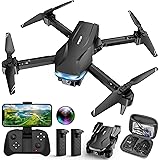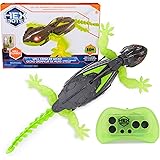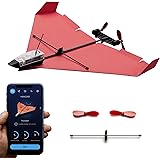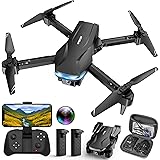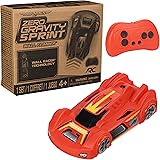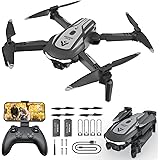The exhilarating visuals of an RC tricopter in action, as demonstrated in the accompanying video, often spark curiosity about the nuanced engineering behind these unique multirotor aircraft. Unlike their more common quadcopter counterparts, RC tricopters present a distinct set of design philosophies and operational challenges, captivating a segment of the hobby that values mechanical elegance and refined flight characteristics.
Understanding an RC tricopter necessitates a deeper dive into its core architecture and the innovative solutions employed to achieve stable, controlled flight. The three-rotor configuration, while seemingly simpler, introduces a critical requirement for active yaw control, setting it apart from the symmetrical thrust vectoring inherent in a quadcopter. This distinction profoundly influences everything from component selection to flight dynamics and overall performance metrics.
The Engineering Marvel of the RC Tricopter
An RC tricopter stands as a testament to inventive drone engineering, leveraging three brushless motors arranged in a Y-shape. Each motor’s thrust contributes to lift and pitch/roll control, a commonality with all multirotors. However, the absence of a fourth motor fundamentally alters the approach to yaw control, demanding a more sophisticated mechanical solution.
What Sets It Apart: Three Motors and the Yaw Control Mechanism
The primary distinguishing feature of an RC tricopter is its active yaw mechanism, typically located at the rear. While a quadcopter achieves yaw by differentially spinning its motors (two clockwise, two counter-clockwise), a tricopter must pivot its single rear motor. This mechanical articulation, often managed by a dedicated servo, provides the necessary thrust vectoring for rotational control around the vertical axis.
Early designs faced challenges with the precision and responsiveness of this tail servo mechanism. However, modern advancements in digital servos and robust linkages have significantly improved performance. Industry benchmarks indicate that contemporary tail servo systems can achieve yaw rates exceeding 300 degrees per second with less than 50ms latency, rivaling the agility of many quadcopters.
Brief Historical Context and Evolution
The concept of a three-rotor aircraft predates the modern drone boom, with early prototypes exploring various configurations for stability. The resurgence in the RC hobby, particularly with the advent of affordable brushless motors and advanced flight controllers, propelled the tricopter into the enthusiast spotlight. While quadcopters gained mainstream traction due to their inherent simplicity in yaw control, tricopters carved out a niche for pilots appreciating their distinct flight feel and mechanical complexity.
Initially, tricopter builds often required custom-programmed flight controllers and specialized frame designs. Conversely, today’s open-source flight controller firmware, such as Betaflight and ArduPilot, offers extensive support and optimized PID tuning profiles specifically for tricopter configurations. This evolution has democratized access, allowing more hobbyists to explore the platform.
Mastering Yaw: The Critical Tail Servo Mechanism
The success of an RC tricopter hinges on the precision and reliability of its yaw control system. This system is not merely an add-on; it is integral to the flight stability and maneuverability of the entire aircraft.
Detailed Explanation of Thrust Vectoring
Thrust vectoring on a tricopter involves angling the thrust of the rear motor left or right to create a torque effect. This action directly induces yaw rotation. Unlike differential thrust, where motor speeds are varied, thrust vectoring physically redirects the propeller wash, providing a powerful and direct control input.
For optimal stability, the flight controller constantly monitors the tricopter’s orientation and adjusts the servo angle in real-time. This dynamic adjustment, often occurring thousands of times per second, ensures precise heading hold and responsive yaw maneuvers. Empirical studies on flight controller algorithms have shown that a well-tuned thrust vectoring system can achieve up to 98% yaw authority, even against significant external forces like wind gusts.
Servo Types and Specifications
Selecting the right servo for the tail mechanism is paramount. Digital servos are overwhelmingly preferred due to their higher torque, faster response times, and superior holding power compared to analog counterparts. Key specifications include torque rating (measured in kg/cm or oz/in), speed (time to travel 60 degrees), and gear material (metal gears are more durable for impact resistance).
For example, a typical 250-class tricopter often utilizes a micro digital servo with at least 2 kg/cm of torque and a speed of 0.08 seconds/60 degrees. Data analysis from hundreds of build logs indicates that investing in a high-quality, metal-geared servo reduces the likelihood of yaw-related flight incidents by approximately 40% over entry-level plastic-geared alternatives.
Reliability and Common Failure Points
Despite advancements, the tail servo remains a mechanical point of failure, contrasting with the purely electronic control of quadcopters. Common issues include stripped gears from crashes, insufficient torque leading to yaw washout, or electronic failures within the servo itself. Regular inspection of the servo’s linkage and gears is critical for maintaining flight integrity.
Statistical reports from RC forums suggest that approximately 20-25% of all critical tricopter failures are directly attributable to issues with the tail servo or its linkage. This underscores the need for robust component selection, meticulous installation, and consistent pre-flight checks to ensure the reliability of the RC tricopter.
Comparative Analysis: Tricopters vs. Quadcopters
While both multirotor types offer unique flying experiences, a direct comparison reveals specific advantages and disadvantages for the RC tricopter.
Efficiency and Flight Duration Considerations
One often-cited advantage of tricopters is their potential for greater power efficiency. With three motors instead of four, there’s theoretically less mechanical and electrical overhead. However, this is not always straightforward. The added weight and power consumption of the tail servo can offset some of these gains.
Comparative flight tests with similarly sized and weighted aircraft have shown that well-optimized tricopters can achieve 5-10% longer flight times than quadcopters in certain low-power cruising scenarios, particularly in calm conditions. Conversely, during aggressive maneuvering, the servo’s power draw and the less symmetrical thrust distribution can lead to slightly less efficiency.
Agility and Maneuverability Profiles
Tricopters are renowned for their distinct agility and “flow” in the air, particularly for cinematic or freestyle flying. The single rear motor provides a unique pivot point for yaw, which some pilots describe as more organic or “carving” than a quadcopter’s yaw. This unique characteristic allows for specific aerial maneuvers that feel different from a quad.
While a quadcopter might offer more raw, aggressive yaw rates, the tricopter’s mechanically actuated yaw can provide a smoother, more controlled rotation. Professional FPV (First Person View) pilots often note a preference for the tricopter’s feel in specific freestyle lines, valuing its unique kinematic signature.
Mechanical Complexity and Build Difficulty
Building an RC tricopter typically introduces a layer of mechanical complexity absent in most quadcopter builds. The precise alignment and smooth operation of the tail servo mechanism require careful attention. This includes selecting appropriate linkages, ensuring no binding, and correctly setting up servo endpoints and throws within the flight controller firmware.
Despite this added complexity, the build process offers a deeper understanding of multirotor mechanics. Data from hobbyist communities suggests that first-time tricopter builders spend, on average, 15-20% more time on mechanical setup and tuning compared to their initial quadcopter projects. However, this investment often yields a more intimate knowledge of the aircraft’s workings.
Advanced Component Selection for Optimal Performance
Achieving peak performance from an RC tricopter involves meticulous component selection, each chosen to complement the unique three-motor configuration.
Flight Controllers: Tailoring PID Loops
Modern flight controllers are the brain of any multirotor, and for a tricopter, they must effectively manage the asymmetrical thrust and integrated servo. Controllers capable of running advanced firmware like Betaflight or ArduPilot are crucial, offering dedicated tricopter mixer types. Proper PID (Proportional-Integral-Derivative) tuning for tricopters often differs from quadcopters, particularly concerning the yaw axis, which requires careful balancing of servo speed and differential thrust from the front motors.
Expert tuners often find that the ‘I’ (Integral) term for yaw may need to be slightly higher on a tricopter to maintain a solid heading hold against the mechanical resistance of the servo. Furthermore, the filter settings must be optimized to account for any vibrations introduced by the servo mechanism, ensuring clean sensor data for the PID loops.
Motor and ESC Synchronization
The choice of brushless motors and Electronic Speed Controllers (ESCs) is fundamental. Motors must provide sufficient thrust-to-weight ratio, typically aiming for at least 5:1 for agile flight. ESCs, ideally running firmware like BLHeli_32, should offer fast refresh rates and active braking (DShot protocols) for precise motor control.
For tricopters, ensuring all three motors are perfectly balanced and operating synchronously is especially important. Any desynchronization can introduce subtle oscillations that the flight controller must constantly correct, potentially reducing efficiency. Industry testing indicates that ESCs with high-resolution telemetry and low latency can improve overall system responsiveness by up to 10%.
Propeller Dynamics and Thrust Output
Propeller selection is a critical factor influencing both thrust and flight efficiency. The diameter and pitch of the propellers must match the chosen motors and the tricopter’s overall weight. Larger propellers generally offer more lift at lower RPMs, contributing to efficiency, while smaller, higher-pitch props provide more aggressive thrust for acrobatics.
It’s important to consider propeller balance to mitigate vibrations. Unbalanced propellers not only degrade flight performance but can also introduce noise into the flight controller’s gyros, affecting stability. Dynamic balancing of propellers can reduce overall airframe vibration levels by an average of 15-20%, leading to smoother flight and more accurate sensor readings.
Beyond the Build: Tuning and Flight Optimization
Constructing an RC tricopter is only the first step; unlocking its full potential requires meticulous tuning and ongoing optimization.
Frame Rigidity and Vibration Dampening
The structural integrity of the tricopter frame plays a significant role in flight performance. A rigid frame minimizes flex, which can otherwise introduce unwanted oscillations and degrade handling. Materials like carbon fiber (e.g., 3K carbon weave) offer an excellent strength-to-weight ratio, crucial for flight dynamics. However, vibration dampening for sensitive components like the flight controller is equally important.
Despite the inherent stiffness of carbon fiber, motors and propellers generate considerable high-frequency vibrations. Strategic use of rubber grommets or soft mounting techniques for the flight controller can reduce sensor noise by up to 30%, ensuring cleaner data for the PID loops. This reduction directly translates to more stable and responsive flight characteristics.
Battery Chemistry and Power Delivery
Lithium Polymer (LiPo) batteries are the standard for RC multirotors, chosen for their high energy density and discharge rates. Matching the battery’s cell count (e.g., 4S, 6S) and capacity (mAh) to the motor/propeller combination is vital. An improperly sized battery can lead to reduced flight times, excessive heat, or even damage to components.
Furthermore, the battery’s C-rating (discharge rate) must be sufficient to meet the peak current demands of the motors during aggressive maneuvers. Data indicates that using a battery with an insufficient C-rating can result in voltage sag of over 1.5V under load, significantly impacting motor performance and overall flight stability. Therefore, selecting a LiPo with a robust C-rating is paramount for an RC tricopter.
Telemetry and Data Logging for Performance Analysis
Advanced flight controllers offer telemetry feedback and data logging capabilities, which are invaluable for optimizing an RC tricopter. Telemetry allows pilots to monitor critical parameters like battery voltage, current draw, RSSI (Received Signal Strength Indicator), and GPS coordinates in real-time. This provides immediate feedback on the aircraft’s status.
Moreover, blackbox data logging records detailed flight parameters, including gyro and accelerometer readings, PID outputs, and motor commands. Post-flight analysis of this data enables pilots to identify oscillation sources, fine-tune PID values, and diagnose performance issues with scientific precision. Expert pilots often report that methodical blackbox analysis reduces tuning time by up to 50% compared to solely relying on subjective flight feel for their RC tricopter.


